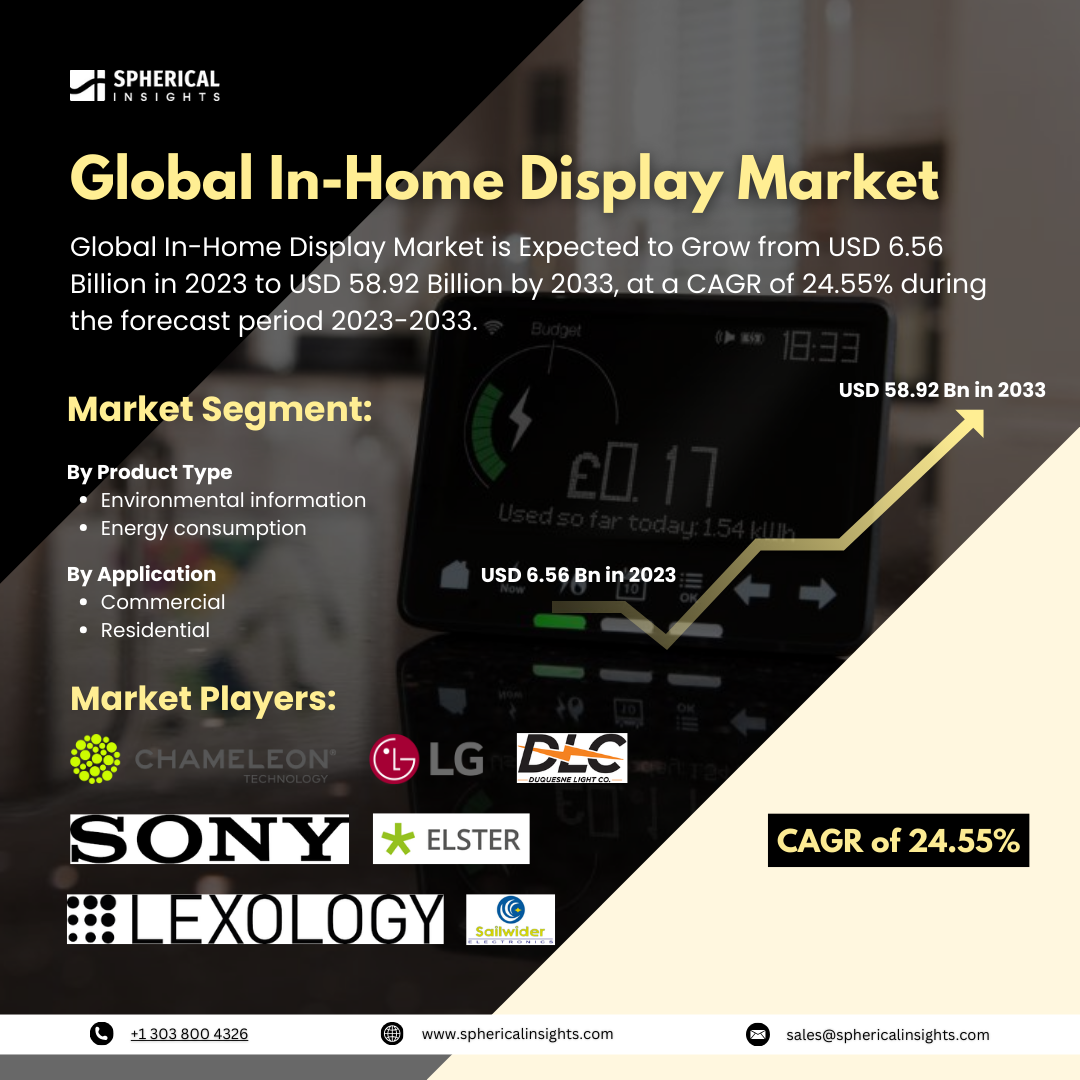Global In-Home Display Market Insights 2024 - 2033
According to a research report published by Spherical Insights & Consulting, the Global In-Home Display Market is Expected to Grow from USD 6.56 Billion in 2023 to USD 58.92 Billion by 2033, at a CAGR of 24.55% during the forecast period 2023-2033.
Browse 210 Market Data Tables And 45 Figures Spread Through 190 Pages and In-Depth TOC on the Global In-Home Display Market Size, Share, and COVID-19 Impact Analysis, By Product (Environmental Information and Energy Consumption), By Application (Commercial and Residential), and By Region (North America, Europe, Asia-Pacific, Latin America, Middle East, and Africa), Analysis and Forecast 2023 - 2033.
The market for displays used in houses, including smart TVs, smart appliances, and other smart home appliances, is known as the "in-home display market." The growing demand for high-definition displays, smart home technology, and energy-efficient displays is driving the market's expansion. The engineer will provide an in-home display, which consists of a small screen, once the smart meters are fully installed in a practical spot. Smart displays are widely used in both retail and sports. The entertainment and healthcare sectors have been impacted by the growing demand for next-generation monitoring and advertising technologies. Furthermore, the integration of cutting-edge technologies like data analytics, smart meters, and wireless networking is what propels the in-home display market. The IHD gadget and utility infrastructure can communicate with one another without any problems due to these technologies. As more people use smart home technologies, there will be a greater demand for in-home displays. However, one significant obstacle to early adoption that is limiting the expansion of the in-home display business is the potential for device failure and customer data breaches.
The energy consumption segment held the greatest share in 2023 and is expected to grow at a CAGR of 22.5% during the predicted timeframe.
Based on the product, the in-home display market is classified into environmental information and energy consumption. Among these, the energy consumption segment held the greatest share in 2023 and is expected to grow at a CAGR of 22.5% during the predicted timeframe. Energy monitors, also known as energy consumption displays, help you keep an eye on and manage your energy usage.
The residential segment dominated the greatest share in 2023 and is anticipated to grow at a CAGR of 20.2% during the forecast period.
Based on the application, the in-home display market is divided into commercial and residential. Among these, the residential segment dominated the greatest share in 2023 and is anticipated to grow at a CAGR of 20.2% during the forecast period. Government initiatives promoting home energy efficiency, smart home technologies, and increased public awareness of energy conservation are the main drivers of the growing demand for household energy management and monitoring systems.
North America is expected to hold the largest share of the in-home display market over the predicted timeframe.
North America is expected to hold the largest share of the in-home display market over the predicted timeframe. There are positive geographical variations in customer preferences and market dynamics in the North American in-home display market. The North American market is characterized by a strong demand for state-of-the-art, technologically sophisticated in-home display products. The market is growing, and customers there are learning more about the benefits of in-home displays made in North America.
Asia Pacific is estimated to grow at the fastest CAGR growth of the in-home display market during the forecast period. The Asia Pacific region market is expanding due to the presence of leading manufacturers, the adoption of new and improved technologies, and users' rising disposable income. Many countries in the Asia-Pacific region are experiencing fast urbanization and population growth. Urban residents are more willing to invest in technology to increase the convenience and security of their houses.
Competetive Analysis
Major vendors in the in-home display market are Chameleon Technology, LG, Sony, Sailwider, Lexology, Geo, Elster, Duquesne Light, Schneider Electric, RiDC, Aztech, and others.
Key Target Audience
- Market Players
- Investors
- End-users
- Government Authorities
- Consulting and Research Firm
- Venture capitalists
- Value-Added Resellers (VARs)
Key Market Development
- In September 2024, the Transformative Interactive Displays from SMART Technologies, a world leader in interactive technology, will be unveiled in Delhi. The SMART Board MX Series® and SMART Board GX Series® interactive displays were also introduced by the firm. SMART is in a unique position to provide Indian schools with locally produced, outcome-focused technology that will support the transformation of India's educational environments because of its more than 35 years of global experience in the interactive technology market, local distribution partners, Indian manufacturing, and locally tailored educational content.
Market Segment
This study forecasts revenue at global, regional, and country levels from 2023 to 2033. Spherical Insights has segmented the in-home display market based on the below-mentioned segments:
Global In-Home Display Market, By Product Type
- Environmental information
- Energy consumption
Global In-Home Display Market, By Application
Global In-Home Display Market, By Regional
- North America
- Europe
- Germany
- UK
- France
- Italy
- Spain
- Russia
- Rest of Europe
- Asia Pacific
- China
- Japan
- India
- South Korea
- Australia
- Rest of Asia Pacific
- South America
- Brazil
- Argentina
- Rest of South America
- Middle East & Africa
- UAE
- Saudi Arabia
- Qatar
- South Africa
- Rest of the Middle East & Africa



